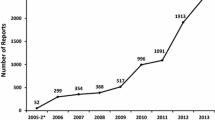Abstract
Objective
The aim of this study was to characterize the pattern of adverse drug reactions (ADRs) reported in a tertiary care teaching hospital.
Methodology
A retrospective study was conducted in the pharmacovigilance center of the Sri Ramachandra Medical College and Hospital, India. ADR data were evaluated for patient demographics, drug and reaction characteristics, and outcome of the reactions. Causality assessment was performed.
Results
A total of 118 ADRs were included in the analysis, with most (70%) being reported in females. Fourteen different drug categories causing ADRs were noted, with antibiotics being the most frequent. The most commonly reported ADRs were pruritus and rash, and the majority of ADRs were reported from the General Medicine Department. Upon causality assessment, the majority of ADRs were rated as being probably drug related. No statistically significant difference was found between causality assessment and age or sex.
Conclusion
Information in the present study may be useful for identifying and minimizing preventable ADRs, and may enhance the ability of prescribers to manage ADRs more effectively and to facilitate the development of a hospital pharmacovigilance service.
Similar content being viewed by others
References
Onder G, Pedone C, Landi F, et al. Adverse drug reactions as cause of hospital admissions results from the Italian Group of Pharmacoepidemiology in the Elderly (GIFA). J Am Geriatr Soc. 2002;50(12):1962–8.
Van Grootheest K, Olsson S, Couper M, et al. Pharmacists’ role in reporting adverse drug reactions in an international perspective. Pharmacoepidemiol Drug Saf. 2004;13(7):457–64.
Gallelli L, Ferreri G, Colosimo M, et al. Retrospective analysis of adverse drug reactions to bronchodilators observed in two pulmonary divisions of Catanzaro, Italy. Pharmacol Res. 2003;47(6):493–9.
Gholami K, Ziaie S, Shalviri G. Adverse drug reactions induced by cardiovascular drugs in outpatients. Pharm Pract (Granada). 2008;6(1):51–5.
Adithan C. National pharmacovigilance program. Indian J Pharmacol. 2005;37:347.
Rajanandh MG, Nageswari AD, Ilango K. Effect of two controller medications with inhaled corticosteroid in mild to moderate persistent asthma patients. J Med Sci. 2014;14:81–6.
Ramesh M, Pandit J, Parthasarathi G. Adverse drug reactions in a south Indian hospital: their severity and cost involved. Pharmacoepidemiol Drug Saf. 2003;12(8):687–92.
Arulmani R, Rajendran SD, Suresh B. Adverse drug reaction monitoring in a secondary care hospital in South India. Br J Clin Pharmacol. 2008;65(2):210–6.
Thong BY. Update on the management of antibiotic allergy. Allergy Asthma Immunol Res. 2010;2(2):77–86.
Uppal R, Jhaj R, Malhotra S. Adverse drug reactions among inpatients in a north Indian referral hospital. Natl Med J India. 2000;13(1):16–8.
Venkatesan R, Ravisankar S, Lakshminarasu M, et al. Intensive monitoring of adverse drug reaction in hospitalized patients in a south Indian tertiary care hospital. Int J Pharm Ther. 2014;5:19–26.
Rajakannan T, Mallayasamy S, Guddattu V, et al. Cost of adverse drug reactions in a South Indian tertiary care teaching hospital. J Clin Pharmacol. 2012;52(4):559–65.
Rao PG, Archana B, Jose J. Implementation and results of an adverse drug reaction reporting programme at an Indian teaching hospital. Indian J Pharmacol. 2006;38:293–4.
Davies EC, Green CF, Taylor S, et al. Adverse drug reactions in hospital in-patients: a prospective analysis of 3695 patient-episodes. PLoS One. 2009;4(2):e4439.
Jose J, Rao PG. Pattern of adverse drug reactions notified by spontaneous reporting in an Indian tertiary care teaching hospital. Pharmacol Res. 2006;54(3):226–33.
Jeetu G, Anusha G. Pharmacovigilance: a worldwide master key for drug safety monitoring. J Young Pharm. 2010;2(3):315–20.
Amrita P, Singh SP. Status of spontaneous reporting of adverse drug reaction by physicians in Delhi. Indian J Pharm Pract. 2011;4:29–36.
Arulmani R, Rajendran SD, Suresh B. Adverse drug reaction monitoring in a secondary care hospital in South India. Br J Clin Pharmacol. 2008;65(2):210–6.
Shamna M, Dilip C, Ajmal M, et al. A prospective study on adverse drug reactions of antibiotics in a tertiary care hospital. Saudi Pharma J. 2014;22(4):303–8.
Lobo MG, Pinheiro SM, Castro JG, et al. Adverse drug reaction monitoring: support for pharmacovigilance at a tertiary care hospital in Northern Brazil. BMC Pharmacol Toxicol. 2013;14:5.
Visacri MB, Souza CM, Sato CMS, et al. Adverse drug reactions and quality deviations monitored by spontaneous reports. Saudi Pharm J. 2015;23(2):130–7.
Sriram S, Ghasemi A, Ramasamy R, et al. Prevalence of adverse drug reactions at a private tertiary care hospital in south India. J Res Med Sci. 2011;16(1):16–25.
Kathiria JM, Sattigeri BM, Desai PM, et al. A study of adverse drug reactions in patients admitted to intensive care unit of a tertiary care teaching rural hospital. Int J Pharm Pharm Sci. 2013;5(1):160–3.
Funding
This research received no specific grants from any funding agency in the public, commercial, or not-for-profit sectors.
Author information
Authors and Affiliations
Corresponding author
Ethics declarations
Conflict of interest
P. Seenivasan, S. Anandan, P.I. Vivek, M.G. Rajanandh, and S. Adikrishnan declare that they have no conflicts of interest.
Rights and permissions
About this article
Cite this article
Seenivasan, P., Anandan, S., Vivek, P.I. et al. Pattern of adverse drug reactions in a regional pharmacovigilance center of a tertiary care teaching hospital. Drugs Ther Perspect 34, 138–141 (2018). https://doi.org/10.1007/s40267-017-0474-y
Published:
Issue Date:
DOI: https://doi.org/10.1007/s40267-017-0474-y




